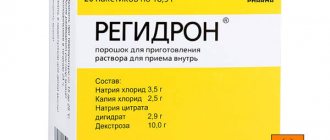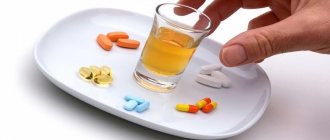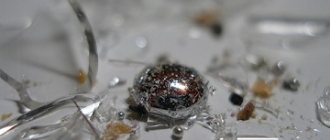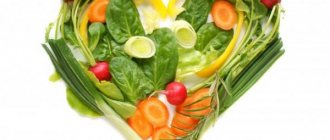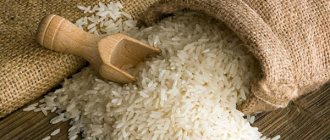Every person has experienced indigestion as a result of eating low-quality foods at least once in their life. Along with the usual signs such as vomiting, diarrhea and general weakness, other symptoms often appear.
Does food poisoning cause fever and how dangerous is it? What measures should be taken in such a case? Before we find out what to do in case of food poisoning with fever, let’s figure out what processes occur during intoxication in the body.
Why does the temperature rise during poisoning?
Food poisoning with fever is a fairly common disease. Very often, one of the signs of consuming foods hazardous to health is an increase in temperature. After all, fever is an excellent protective mechanism developed by nature against pathogens and harmful substances. As body temperature rises, metabolism accelerates, blood circulation and microcirculation of fluid in tissues and organs improves, and the breakdown and removal of toxins from the body accelerates. Sweating increases, skin vessels dilate, which also facilitates the removal of toxins. As the temperature rises, the internal environment becomes unfavorable for most pathogenic bacteria.
According to their type of poisoning, they are divided into:
- microbial - toxic infections, toxicosis;
- non-microbial - poisons of plant and animal origin;
- as well as intoxication with chemical impurities.
There are about 30 potentially dangerous bacteria, including the well-known pathogens of dysentery, colibacillosis, salmonellosis, botulism and cholera, which can cause microbial poisoning.
Another reason why the temperature rises with food poisoning is an imbalance in the intestinal microflora. In the intestines, beneficial bacteria are weakened and conditionally harmful ones, in particular coccal forms, are activated. In any case, the body reacts to such factors with fever. Therefore, in practice it is impossible to distinguish infectious from non-infectious poisoning by the nature of changes in body temperature.
In what cases is temperature dangerous?
Any food poisoning with fever requires immediate medical attention if:
- severe repeated vomiting develops;
- loose stools appear more than 10 times a day or mixed with blood;
- with severe dehydration;
- at the first signs of damage to the nervous system: muscle tremors, convulsions, changes in breathing, disturbances of consciousness, narrowing or dilation of the pupils;
- if after providing first aid measures the temperature remains high, is not brought down by medications or decreases for a short time.
Even with ordinary poisoning from spoiled foods, body temperature can rise to 40 °C. It is dangerous if it rises above 38.5 °C or lasts more than a day.
Medical treatment
First aid is provided by a team of doctors who responded to the call. They collect anamnesis, examine the patient, and check his vital signs. Tell them in detail what kind of food the patient was poisoned with, and how you managed to help him yourself before their arrival.
The medical team can provide the following assistance:
- Gastric lavage through a tube is performed in cases of poisoning with acids or alkalis, as well as in young children.
- Dropper based on saline and glucose. It is needed to eliminate dehydration and reduce the level of intoxication in the body.
- Intravenous administration of antispasmodics and antiemetics.
- The temperature is reduced when it rises above 38.5 degrees. All drugs are administered intramuscularly or intravenously.
After providing first aid, doctors hospitalize the patient in the infectious diseases department. If he is poisoned by chemicals, he is taken to toxicology. If the patient’s condition is severe, treatment is carried out in an intensive care unit (resuscitation room).
The length of stay in the hospital depends on the etiology of the disease , the patient’s condition, and the timeliness of contacting doctors. The temperature after poisoning can last up to 3 days.
Treatment of poisoning with fever
Doctors do not recommend using any antipyretics if the thermometer shows no more than 38.5 °C. Indeed, in this case, high temperature is a helper, and not a source of danger.
Food poisoning up to 38 °C is treated according to the general scheme. After relief of the body's condition, this indicator returns to normal within the first day.
Let us consider in detail how to treat food poisoning with fever.
- Gastric lavage with plenty of salted water or a slightly pink solution of potassium permanganate.
- Taking adsorbents - activated carbon at the rate of 1 tablet per 10 kg of weight, Enterosgel, Polysorb MP and other drugs.
- Laxative – 30 grams of magnesium or sodium sulfate in 400 ml of water.
- Cleansing enema with saline solution or decoction of chamomile and calendula.
- Drink plenty of water - boiled water, a decoction of herbs (chamomile, calendula, St. John's wort). At the same time, take into account that for every degree the temperature rises, you need to drink an extra liter of liquid.
It is also not recommended to stop diarrhea with the help of fixative drugs - this will interfere with the removal of toxic substances from the body. The first day after food poisoning with fever, a starvation diet is used as treatment. On the second day, eat bland food - liquid porridge, mashed potatoes, hard-boiled eggs.
The role of dietary nutrition in rehabilitation after poisoning
In order for the patient’s body to recover faster after poisoning, dietary nutrition is prescribed. It is worth considering that in the acute phase of the disease, therapeutic fasting is indicated, which generally lasts 24 hours. Next, light food is introduced in small portions. Nutritionists recommend the food intake scheme given below.
- Baked apples. You can bake it with the addition of honey, as it is a source of electrolytes and nutrients.
- Ripe bananas. If the fruits are not too ripe, they are immersed in boiling water for a few seconds. This allows you to remove excess starch, which can add complications to an already weak stomach.
- Viscous porridge. Rice, buckwheat or oatmeal are boiled for a long time in large amounts of water. It turns out to be a messy diet porridge. You can use chopped cereal.
- The second broth is made from lean meats. Chicken breast, veal or lean pork will do.
- Liquid mashed potatoes.
- Boiled eggs.
A few days later, after the condition returns to normal, fermented milk products are included in the patient’s diet. Biokefir has a particularly good effect on the restoration of the gastric mucosa. It helps fill the stomach with beneficial microorganisms. If you are poisoned with a fever, you can take various probiotics that will speed up the recovery process.
Temperature due to food poisoning in a child
Fever due to food poisoning in a child is a more serious problem than in adults. It is necessary to accurately establish the cause of the disease, for which you should consult a doctor. It is mandatory to receive qualified assistance even if the injured child is less than three years old. Children are more susceptible to poisoning and quickly develop dehydration, which is more difficult to replenish at home.
How to treat food poisoning with fever in children? Focus on the following recommendations from doctors.
- Do not knock down if it is below 38.5 °C. This rule does not apply to those children who have chronic diseases, a tendency to seizures, or signs of deterioration: severe chills, muscle and joint pain, pallor.
- To reduce body temperature, rubdown is first used. Children under three years of age are wiped with a towel or napkin soaked in water at room temperature. For older people, use a solution of 9% table vinegar diluted with water 1:1. They wipe their hands, feet, neck, chest, face. A wet wipe is placed on the child's forehead.
- When using medications, the dose should be agreed upon with the attending physician, since the body, weakened by toxins, will react differently to the antipyretic. Prescribe tablets or rectal suppositories based on paracetamol or ibuprofen. It is not recommended to give antipyretic syrups and powders, as they contain ballast substances: dyes, flavors, etc., which are undesirable if the stomach and intestines are hypersensitive.
Children should not use antipyretic drugs from the group of Aspirin, Analgin and Amidopyrine - these drugs have many side effects.
- You can take antipyretic drugs again only after 5–6 hours. If there is no effect from their use, call an ambulance.
- To replenish fluid loss, give plenty of fluids: boiled water (add 3 tablespoons of sugar and 1 teaspoon of salt per 1 liter). Or use pharmaceutical solutions: Regidron and others.
- A cleansing enema for children is done with starch jelly.
You need to know that in a child under one year old, a temperature of up to 37.4 °C is considered normal. And at any age, the thermometer reading in the mouth will be half a degree higher than in the armpit.
In any case, at the first signs of poisoning - nausea, vomiting, diarrhea - first aid measures must be taken. To do this, wash the stomach, take activated carbon or other adsorbents, and use a laxative. If your body temperature rises to 38.5 °C, do not worry - this is how the body fights toxins. In this case, antipyretics are not used. But if the temperature is high or does not decrease during the day, you should seek medical help.
Is there a fever during poisoning? This is the question that many people ask when faced with fever or fever after intoxication of the body. The answer is definitely yes! High temperature is one of the symptoms of food poisoning, which can develop in both adults and children.
In this article we will look at the etiology of fever during foodborne illness, as well as methods and features of its reduction.
How to return to normal life?
When the main course of therapy is completed and the sick leave is closed, the person quite often continues to experience loss of appetite and weakness. There may be slight increases in temperature in the evening - these are the so-called temperature “tails”.
How to restore strength and alleviate the condition? The following recommendations may be taken into account:
- A course of multivitamins or simply a complete diet, balanced with all the main components of the daily menu: carbohydrates, fats and proteins, is useful. The diet must include the required amount of fruits and vegetables - sources of vitamins .
- During the fight against infection, the liver experiences a very high load. You can complete a course of restorative treatment with hepatoprotectors for a month. This group of herbal products reduces the effects of intoxication.
Fighting intoxication of the body, which causes deterioration in well-being and many unpleasant symptoms, correctly chosen antiviral therapy is the key to successful treatment and prevention of severe consequences, most dangerous for weak patients and children.
A disease such as ARVI is familiar to everyone - both adults and children. High fever, muscle aches, chills, as well as cough and runny nose. All these symptoms indicate an acute viral infection. Viral infections are dangerous not only because of complications from the upper respiratory tract that appear after the disease has been transmitted. During the height of the disease itself or after it, the body often cannot withstand the load. Sometimes, when vital organs are damaged, intoxication develops.
Symptoms of intoxication manifest themselves differently for everyone, but the course of the viral infection worsens significantly. What are the signs of intoxication during ARVI in adults and children? How can we help the body reduce the harmful effects of illness during illness? Let's discuss this.
What does an increase in temperature indicate during poisoning?
There are 3 types of intoxication:
- microbial (poisoning from spoiled or poor-quality food);
- non-microbial (poisoning by poison of animal or plant origin);
- poisoning with chemical reagents.
If the temperature rises during poisoning, it is highly likely that microbial intoxication has occurred. It is bacteria and the products produced during their vital activity that provoke an imbalance in the thermal balance of the human body.
The main causes of high temperature during intoxication
Can there be fever or fever if poisoned? Of course! Let's try to figure out in what cases this happens.
The main reasons for increased body temperature during poisoning are:
- infectious intestinal infection. In case of poisoning, salmonellosis, E. coli or dysentery can enter the intestines, causing severe intoxication and inflammation of the intestinal walls. They enter the body through spoiled food or through unwashed dishes and dirty hands. The immune system begins to fight pathogenic microorganisms, which is why the poisoned person develops a fever. In cases of bacterial intestinal infection, the temperature remains around 38 degrees;
- acute gastritis. Toxins and chemicals irritate the stomach lining, causing inflammation. Gastritis develops, accompanied by severe pain in the stomach cavity, nausea and vomiting. In this condition, the temperature usually does not exceed 37.5 degrees;
- pancreatitis. Under the influence of toxic substances, the pancreas becomes inflamed. With acute damage to this organ, unbearable abdominal pain and a temperature in the region of 38.5-39.5 degrees are observed. This condition is subject to surgical treatment in a hospital;
- severe dehydration. The body is deprived of fluid after repeated vomiting and diarrhea. Weakness appears, the skin becomes flabby and pale, and the eyeballs sink. This also causes thickening of the blood and disruption of the heart and brain. All this can cause a significant increase in temperature.
Contraindications to churning and possible complications
In case of food poisoning, it is not recommended to lower the temperature in the following cases:
- Not a pronounced temperature reaction (up to 38 degrees).
- Less than 4 hours have passed since taking the antipyretic.
- The presence of allergic reactions to the components of the drug.
Complications of hypothermic drugs:
- Hypothermia.
- Development of stomach ulcers, exacerbation of peptic ulcers with long-term use of most NSAIDs.
- Decreased leukocytes and platelets in the blood.
- Effect on the liver (paracetamol has a hepatotoxic effect).
- Reye's syndrome in children with long-term oral administration of acetylsalicylic acid. Progressive encephalopathy, cerebral edema, hyperammonemia, and fatty liver develop.
Antipyretic drugs do not treat the underlying disease; they relieve hyperthermia. The sooner you start detoxification therapy for food poisoning, the better for the patient.
Food poisoning is accompanied by nausea, vomiting, diarrhea, and abdominal pain. An increase in body temperature requires consultation with a doctor and intensive care.
Poisoning is a disruption of the functioning of body systems as a result of the ingress of pathogenic microorganisms, toxins, poisons, and chemicals. As a result of violation of sanitary and hygienic rules, rules and regulations for food storage, careless handling of chemicals and toxic substances, poisoning can occur.
The acute phase is accompanied by unpleasant symptoms, such as: nausea, vomiting, dizziness, weakness, increased salivation, severe abdominal pain and fever. We will discuss in this article whether to lower the temperature during poisoning and how to reduce it.
What to do at temperatures up to 38-38.5 degrees?
If the temperature after poisoning has increased slightly and does not exceed 38.5 degrees, doctors strongly recommend not to lower it. This reaction indicates an intense struggle of the immune system with toxic substances that have entered the body. All actions in such a situation should be aimed at eliminating the symptoms of intoxication and removing toxins . After the gastrointestinal tract is cleansed of harmful substances, temperature indicators return to normal.
To quickly remove toxic compounds, you must act in the following sequence:
- Rinse the stomach. The poisoned person is given about 1-1.5 liters of clean liquid to drink, after which they induce “artificial” vomiting by pressing (not too hard) on the root of the tongue.
- Use sorbent. After cleansing the stomach cavity, you need to take the sorbent. This drug will help remove the remaining toxic substances from the digestive tract. You can choose one of the following sorbents: Smecta, Enterosgel, Polysorb, Activated carbon.
- Drink a lot. Drinking plenty of fluids is a must, but you need to drink in small portions: 2-3 tablespoons every 10-15 minutes.
- Normalize the water-salt balance with the help of special preparations: Regidron, Trihydron, Gidrovit.
- Give an enema. The pear is filled with warm boiled water, the end is greased with Vaseline and the contents are introduced into the small intestine.
Important! In a person suffering from diseases of the circulatory, cardiovascular, and endocrine systems, it is necessary to bring down the temperature to 38 degrees. Otherwise, serious health problems may arise.
Actions at temperatures of 38.5 and above
In case of poisoning, it is imperative to lower the temperature if the readings on the thermometer exceed 38.5 degrees. For such purposes, it would be rational to carry out the following procedures:
- vinegar wrap;
- using cold compresses on the forehead;
- wiping the skin with water, water or vinegar solution;
- drinking plenty of water;
- taking antipyretic drugs;
- use of folk recipes.
Important! If you have a severe fever with an increase in body heat above 38.5-39, you should definitely seek help from a medical facility.
Many medications can irritate the gastric mucosa and worsen the condition of the poisoned person. If the patient develops gastritis or pancreatitis, analgesics are contraindicated for him!
The following antipyretic drugs are considered less aggressive and safer:
- suppositories with Ibuprofen or Paracetamol;
- Nimesulide;
- Nise;
- Nimesil;
- Paracetamol;
- Ibuprofen;
- Nurofen.
If an adult’s fever cannot be brought down with such drugs, doctors administer a mixture of Analgin and Diphenhydramine.
Necessary actions
You can reduce the temperature in case of poisoning thanks to many effective antipyretics. The drugs are aimed at gradually lowering the temperature, eliminating inflammation, and fighting intoxication. The thermometer may show elevated numbers. You need to know when to lower the temperature.
37-38 degrees
Doctors do not recommend lowering the readings below 38 degrees. With such numbers, the body can cope with the problem. If you take antipyretics, your immune system will weaken and your defense mechanisms will not do their job properly. You need to focus your energy on fighting intoxication: drink more warm liquids (unsweetened tea with lemon, plain water), stay in bed, treat symptoms of intestinal infection (enterosorbents, antiemetics).
Caring mothers forget medical recommendations and begin to reduce insignificant numbers. Let children's immunity develop so that in the future the child will not be hostage to colds. Hyperthermia will subside due to its own protective mechanisms.
An increased drinking regime will do the trick.
From 38.5 and above
If you bring down the elevated temperature during food poisoning, you can alleviate the patient’s condition. Fever, unlike low-grade fever, needs to be reduced. High numbers on the thermometer indicate the body’s inability to cope with the disease on its own, and it needs help. Measures to reduce body temperature:
- Place cold on large vessels.
- Wipe the skin with cold water or vinegar solution.
- Don’t bury yourself in blankets, open up, let your body release excess heat naturally.
- Taking antipyretic drugs treats an unpleasant symptom and helps get rid of inflammation.
Effective hypothermic agents:
- Paracetamol has analgesic, antipyretic, and weak anti-inflammatory properties. Affects the synthesis of prostaglandins and reduces the reaction. Paracetamol is included in many medications. Available in tablet form. For children, there are syrups with a measuring spoon, the dosage of which is determined according to the age of the child. In pediatrics, 2 medications are allowed: ibuprofen, paracetamol.
- Ibuprofen is a non-steroidal anti-inflammatory drug. Blocks the synthesis of COX-1 and COX-2. Effective, inexpensive and effective antipyretic.
- Mefenamic acid belongs to the anti-inflammatory and antipyretic drugs.
- Analgin + diphenhydramine + papaverine intramuscularly or intravenously is used in hospitals and ambulances to quickly reduce temperature.
It is not recommended to sharply reduce hyperthermia so as not to put a person into a state of hypothermia.
Food poisoning is easy, but treating intoxication is difficult and time-consuming. If the readings rise over 39 degrees for a long time, antibiotics are prescribed to kill toxins.
The temperature will rise for several days, the main thing is to carry out detoxification therapy (remove accumulated toxins).
Traditional recipes to combat fever and fever
- dill decoction with honey . Take 1 teaspoon of dill (fresh or dry) and pour a glass of boiling water. Simmer for 15-20 minutes on low heat. Add half a glass of boiling water and 1 dessert spoon of honey to the finished broth. Drink half a glass of this herbal infusion half an hour before meals;
- ginger tea . To prepare tea you need 1 dessert spoon of ground ginger. Add a glass of boiling water to this mixture and infuse the drink for 20 minutes. Drink 1 dessert spoon of the finished tea every 25-35 minutes. To improve the taste of the drink, you can add a small amount of sugar or honey;
- enema based on tincture of chamomile flowers. The tincture is prepared from 4 chamomile flowers (pharmaceutical) and 1 liter of boiling water. This mixture is heated in a water bath for 10-15 minutes and allowed to cool. The finished decoction can be used for an enema.
What to do with fever after intoxication in children?
A child's temperature during poisoning is especially dangerous. Doctors recommend knocking it down when the readings rise above 38.5 degrees.
Let's look at how to deal with fever after poisoning in childhood:
- It is useful to wipe with a damp cloth or towel dipped in a solution of vinegar and water (they are mixed in equal quantities). You can also place the napkin on your forehead for a few minutes;
- antipyretic drugs contain a lot of dyes, so it is better to use products designed for rectal use. Cycloferon, Ibufen or Paracetamol rectally will do;
- Under no circumstances should you use antipyretics from the Aspirin, Analgin or Amidopyrine groups. They have serious side effects on the child's body;
- for children, the most effective and safe drugs to combat fever are Paracetamol in the form of a suspension or syrup;
- If a child has fever and diarrhea, it is strictly forbidden to use fixatives. This will only aggravate the situation and will contribute to the activation of toxins in the digestive tract.
Temperature in case of poisoning is observed quite often. It is important to measure it and ensure that the mark on the thermometer does not exceed 38-38.5 degrees. If after carrying out first aid measures there is no improvement, it is necessary to call ambulance workers. It is better to entrust the choice of methods for combating high fever to an experienced doctor. This will help maintain the health of the poisoner!
How to bring down the temperature
It is generally accepted that you need to try to relieve a fever if the temperature has reached 38.5 °C. But if even with these indicators a person feels well, there is no need to rush into taking antipyretics.
In general, you can help a poisoned person cope with a fever using traditional or folk remedies. If you use folk recipes, you need to understand that they are not the main treatment and only provide an auxiliary effect.
. Their use should be discussed with a doctor, since even harmless “non-chemical” agents have their own contraindications.
Traditional methods
The following remedies and measures will help to slightly lower body temperature in case of poisoning and alleviate the condition:
- Cooling the body. These include wet cloth wraps, rubbing ice cubes on the temples and neck, cold compresses on the forehead, and ice packs
. The method does not guarantee a reduction in fever to normal, but the temperature will become slightly lower. - Decoctions with antipyretic effect. They are prepared without sugar from linden flowers, willow bark, strawberry leaves or poplar buds and have anti-inflammatory, bactericidal and antipyretic effects.
- Drink plenty of fluids. It is recommended by both folk and traditional medicine. Black and green teas, chamomile or calendula tinctures will be useful
. Another remedy - dill-honey water also reduces fever quite well, but is not suitable for people with allergies to honey.
Children tolerate hyperthermia less well than adults. However, not all medications are allowed for them due to age or due to individual contraindications
. Therefore, easy folk remedies can be very useful, but it is important:
- do not wrap the child up;
- put him to bed undressed, covering him with a sheet or thin blanket;
- warm the baby's hands and feet;
- give the baby more water;
- Give the poisoned child an enema with warm water.
These simple folk remedies can really help both adults and children at home when their temperature rises. But it’s better to play it safe and call a doctor.
Can there be a fever during poisoning?
An increase in temperature during poisoning is a common occurrence. Fever develops as a protective mechanism in response to intoxication due to the action of pathogenic microorganisms and toxic substances. Due to the increase in temperature, metabolic processes are accelerated, sweating increases, which increases the rate of removal of toxins. In addition, the production of antibodies and interferon improves. All this helps to enhance the capture of bacteria by immune cells, which remove them from the body. Fever can accompany a person for 1-2 days, in more severe cases – 5-7 days.
How long does the temperature last
The temperature can last from 1–2 days to a week. For dangerous food poisoning (for example, septic salmonellosis) - up to a month
. But this is generalized information, and in each specific case everything will be individual.
But with any poisoning, the heat will not decrease until the toxins are eliminated. Until the body is cleansed of poisons or microorganisms, there can be no talk of recovery (and reduction of fever, of course)
. For this purpose, completely different drugs are prescribed - sorbents, astringents, sometimes antibiotics, etc.
Temperature is not always a reason to panic, but it cannot be ignored either. The human body is very smart and knows how to signal if something is wrong with your health.
. You just need to listen to him and act according to medical instructions.
https://youtu.be/njr9FfeieJ8
Poisoning is not the last place in medical statistics. They are accompanied by nausea, vomiting, diarrhea and painful abdominal cramps
.
Elevated temperature worsens the condition even more. When increasing it to certain values, it is not recommended to reduce the heat
.
If the temperature is too high and is accompanied by fever, the patient needs the help of a gastroenterologist
. This is especially true for children, whose bodies cannot simultaneously fight inflammation and infection.
Causes
There are three main types of intoxication of the body: microbial (poisoning with low-quality food), non-microbial (associated with poisons of plant or animal origin), damage by chemical reagents. An increase in temperature is more often observed in the first form. Bacteria and their metabolic products provoke disturbances in the body's thermal balance. Among the more specific causes of hyperthermia due to poisoning are the following:
- Acute gastritis. It develops due to irritation of the gastric mucosa by toxins and chemicals. Gastritis is accompanied by pain in the epigastric region, nausea and vomiting. The temperature does not rise above 37.5 °C.
- Botulism. The most serious disease that develops rapidly - literally in a couple of hours. Accompanied by tireless vomiting, diarrhea, and a thick “veil” before the eyes.
- Infectious intestinal lesions. It is provoked by E. coli, salmonellosis, and dysentery. They cause severe intoxication of the body. Intestinal poisoning with a temperature around 38 °C is a common occurrence. The reasons for the penetration of bacteria into the body are spoiled food and poor personal hygiene.
- Pancreatitis. Due to the influence of toxic substances, the pancreas can also become inflamed. Its defeat is accompanied by acute unbearable abdominal pain and hyperthermia at 38.5-39.5 °C. Pancreatitis is treated only through inpatient surgery.
- Severe dehydration. Due to repeated vomiting and diarrhea, the body loses a large amount of fluid. As a result, dehydration develops, which is accompanied by weakness, pale and flabby skin. When the water level is low, the blood thickens, which disrupts the functioning of the brain and heart.
The child has
Children suffer more severely from food poisoning, since the body is not yet strong enough to be much more sensitive to various toxins. The reasons for the rise in their temperature during intoxication are almost the same as those characteristic of adults:
- acute gastritis;
- severe bacterial intoxication (intestinal infections, including viral);
- food poisoning;
- incorrectly selected treatment, in which the reserves of water and electrolytes in the body are not replenished.
Separately, it is worth noting acetonemic syndrome - an increase in the level of ketone bodies in the urine. This condition is typical for childhood poisoning. It is accompanied by the smell of acetone from the mouth, dehydration, uncontrollable vomiting, and hyperthermia. Pancreatitis, acute or chronic, is a frequent complication of childhood poisoning. Hyperthermia reaches values of 37-37.5 °C. Against this background, vomiting, nausea, and girdle pain in the abdomen are observed.
Reduced temperature
The state of the body in which the temperature is low and does not exceed 36 °C is called hypothermia. Rubbing with a warm towel and a light massage can help cope with this. In case of poisoning, hypothermia is possible in case of intoxication with the following products:
- toxins, poisons;
- medicinal herbs that can cause a toxic effect;
- chemicals;
- alcohol (poor quality drink or in case of alcoholic coma).
A decrease in temperature can be associated with a lack of vitamin C in the body. Against the background of hypothermia, a person additionally develops other symptoms:
- numbness of the limbs;
- slight tremor of fingers;
- pale skin;
- cold clammy sweat;
- drowsiness;
- dizziness.
How to detoxify the body at home?
The intensity of treatment measures will depend directly on the severity of intoxication in the body. In mild situations, which almost always occur with a certain type of acute respiratory viral infection, treatment can be performed at home . The treatment algorithm looks like this.
Mode
Provide rest to the patient. Semi-bed rest or bed rest with limited TV viewing and full sleep is recommended The room in which the patient is located must be ventilated periodically. This will reduce the concentration of viral microparticles and intoxication products in the air, which are excreted in sweat and inhaled in the air. The patient can be in the room - he just needs to be well covered. When the air is dry, which most often happens in winter in heated rooms, you can hang wet towels on the radiators. If money allows, then buy a special humidifier.
Diet
In case of intoxication, heavy fried and fatty foods are prohibited. The best option is a dairy and plant-based diet that is gentle on the liver and gastrointestinal tract. It is necessary to limit the consumption of meat foods. Preference should be given to products made from cottage cheese and cereal dishes. You should not get carried away with complex culinary preparations, as well as sweets. It is very important to be gentle with the liver , since this organ is the main tool in the body for removing toxins of various origins during intoxication.
If the patient refuses to eat, there is no need to force feed him; it is better to provide the person with a sufficient volume of fluid . A good folk remedy that strengthens the body’s strength is low-fat chicken broth, which you can simply drink. Along with the broth, you can offer a dried piece of bread.
Drinking regime
With the help of adequate water load, you can independently cope with toxins without resorting to pharmaceuticals. Compotes and fruit drinks made from dried and frozen berries, dried fruits, and even simple purified drinking water cope well with the tasks. Decoctions and infusions of dried fruits have diuretic properties and also contain essential microelements.
Decoctions of rose hips, viburnum, raspberries and linden help reduce intoxication and have a pronounced diaphoretic property. Drinking warm mineral waters will further contribute to the dilution of pathological discharge and sputum from the nose. Water must be still ! For an adult, the volume of water load must reach at least 2 liters.
Why is high temperature dangerous?
The severity of hyperthermia depends on how much the temperature rises. In case of poisoning, a level of 38-39 °C is most often observed. With food intoxication, low-grade fever is observed. This means that it does not exceed the level of 37-37.5 °C. Crossing the mark of 38 already indicates diseases of an infectious nature.
High fever due to food poisoning is both good and bad. Hyperthermia is important for the body's fight against microbes, but with too much heat there is a risk of the following serious abnormalities:
- Brain dysfunctions. He is the first to suffer from intoxication. This is manifested by partial or complete loss of consciousness and lethargy.
- Damage to the nervous system. The patient feels exhausted and constantly wants to sleep. It is common for children to develop seizures.
- Disorders of the cardiovascular system. Each degree increases the number of heart contractions, which causes arrhythmia. It provokes vasospasm and increased blood pressure. Due to stagnation of venous blood, plasma accumulates in the pulmonary alveoli, which can lead to suffocation and pulmonary edema.
- Breathing pathologies. Inhalations and exhalations become more frequent. Breathing becomes shallow.
- Kidney damage. Due to the decrease in fluid volume in the body, protein appears in the urine, which leads to the accumulation of urea in the blood. This only intensifies the existing intoxication.
- Digestive problems. Appetite disappears, dry mouth appears, salivation decreases, and constipation develops due to lack of fluid.
Given these serious complications of hyperthermia, the patient's condition must be constantly monitored. Temperatures above 38.5 °C must be brought down. Indications for seeking medical help are the following symptoms:
- diarrhea more than 10 times a day and with blood;
- repeated vomiting – from 6 times per day;
- a temperature of 38.5 °C lasts longer than a day and does not subside after taking antipyretics or sorbents;
- convulsions, muscle spasms, disturbances of consciousness.
Symptoms and signs of viral intoxication
Most often, infectious diseases are accompanied by symptoms of general intoxication. ARVI is no exception. Fever, constant headache, joint pain, body aches, vomiting and nausea are symptoms of toxic damage to the body that explain the person’s poor health.
Almost all common seasonal viruses cause such complaints, expressed to a certain degree. But the clear leader is the flu.
In addition to the above complaints, as a rule, there are:
- dizziness ; _
- general weakness;
- muscle pain;
- decreased sense of taste and loss of appetite;
- lower blood pressure.
In 50% of cases with ARVI, these symptoms are ahead of the typical manifestations of a cold: sore throat, cough, runny nose. During severe illness, toxic shock , which is accompanied by a sharp decrease in blood pressure.
Examinations for hyperthermia
A very high temperature in case of poisoning in an adult or child (more than 39 °C) requires hospitalization. To determine the cause of hyperthermia, doctors conduct diagnostics, which include several procedures:
- General examination of urine and blood. A laboratory urine test can help identify possible kidney damage. Blood clotting disorders can identify anemia and a bacterial or viral infection.
- Bacteriological examination of feces. It is carried out to detect intestinal infection, its causative agent and its sensitivity to certain antibiotics.
- Biochemistry of blood. Using this analysis, identifying electrolyte shifts helps identify various disorders of the internal organs.
- Ultrasound. Helps to detect and study in more detail pathological processes in internal organs.
- Electromyography. Indicated for diagnosing disorders of the cardiovascular system and identifying heart rhythm disturbances.
What to do in case of fever in case of poisoning in an adult
There is no need to bring the temperature below 38.5 °C in an adult. In children under 3 years of age, the limit is 37.7 °C, especially in the presence of seizures. If their temperature rises above this value, it can be brought down. If an adult or child develops a fever due to hyperthermia, you should call an ambulance. Treatment is aimed at cleansing the body of toxins and allergens. Before taking antipyretics, you should try the following:
- Gastric lavage. You need about 1-1.5 liters of clean water. Next, you need to induce “artificial” vomiting by pressing on the root of the tongue.
- After cleansing the stomach, take a sorbent, for example, activated white or black carbon at the rate of 1 tablet per 10 kg of body weight. Instead, you can use Smecta, Enterosgel, Polysorb.
- Drink plenty of fluids. You need to drink in small sips - 2-3 tablespoons every 10-15 minutes.
- Normalization of water-salt balance. Involves taking Hydrovit, Trihydron or Regidron. The dosage of the latter is calculated based on 10 ml of solution per 1 kg of body weight. Prepare the product by diluting 1 sachet of powder in 100 ml of warm water. In stationary conditions, saline solution is infused intravenously for the same purpose.
- Enema. The syringe is filled with boiled water, the end is lubricated with Vaseline and inserted into the small intestine, after which the liquid is squeezed out there.
What to do if a child with a fever is poisoned
High temperatures are especially dangerous for children. In no case should they be given antipyretics based on aspirin, analgin or amidopyrine, since these substances cause a lot of side effects. In childhood, Paracetamol is more successfully used, which is available for children in the form of syrup and suspension. Even if the medicine is safe, it must still be approved by a doctor. You can reduce the temperature of infants using the following scheme:
- Place the baby on its side. This is necessary so that he does not choke on vomit. Do not feed the baby for the first 2-3 hours. After this time, breast milk can be given to avoid dehydration.
- Wiping with a damp cloth or moistened towel. You can additionally apply a cool compress to your forehead.
- Give an antipyretic. It is allowed to use Paracetamol in syrup dosage: 10 mg/kg for children under 3 months, 60-120 mg for children aged 3 months to one year, 120-250 mg for children 1-5 years old. Ibuprofen can be used in the form of a rectal suppository: for patients weighing 5.5-8 kg - 1 suppository of 60 mg every 6-8 hours, but not more than 3, for patients weighing 8-12.5 kg - 4 suppositories of 60 mg.
- Give plenty of fluids, using boiled water with a small amount of salt in the composition. You can use the drug Regidron. The dosage for children is 30-60 ml of solution per 1 kg of body weight, depending on the severity of dehydration.
What is important to remember about first aid?
In most cases, it is possible to prevent serious complications with first aid at home, but not all recommendations are acceptable and effective. In any situation, an important measure is to protect the patient from the source of the toxin, but the cause cannot always be determined immediately; a comprehensive diagnosis may be required. Even with proper first aid, the patient needs qualified emergency care or complex treatment in a hospital. Any toxic lesion manifests itself in its own way depending on the source of poisoning.
Share with your friends
Do something useful, it won't take much time
Folk remedies
Alternative medicine offers several ways to alleviate poisoning. A decoction of dill and honey helps lower the temperature. It is better to take fresh herbs, but it is not forbidden to use dry ones. One teaspoon of dill is poured into a glass of boiling water and simmered for 20 minutes over low heat. Already add 1 tbsp to the warm broth. l. honey The entire decoction should be drunk during the day, consuming 0.5 tbsp. In addition to this remedy, there are other effective folk recipes:
- Brew 1 tbsp with a glass of boiling water. l. ground ginger, let it brew for 20 minutes. Drink the resulting tea every half hour, 1 tbsp. You can add a little sugar or honey.
- Finely chop the marshmallow root to make 1 tbsp. l. raw materials. Brew it with a glass of boiling water. After half an hour, strain and add a spoonful of honey. Dosage: 1 tbsp. l. every 2 hours – for adults, 1 tsp. at the same intervals - for children.
- Brew 4 tbsp. l. dried chamomile flowers with a liter of boiled water. Heat the mixture in a water bath for about half an hour. Cool the herbal tea and strain. Drink 200 ml twice a day.
- Pour a liter of boiling water over 1 tbsp. l. crushed dried linden flowers. After 3-5 minutes, strain the product and let it cool until warm. Dilute a little with boiled water. Drink the entire broth in one gulp.
https://youtu.be/Y594gDUFEno



